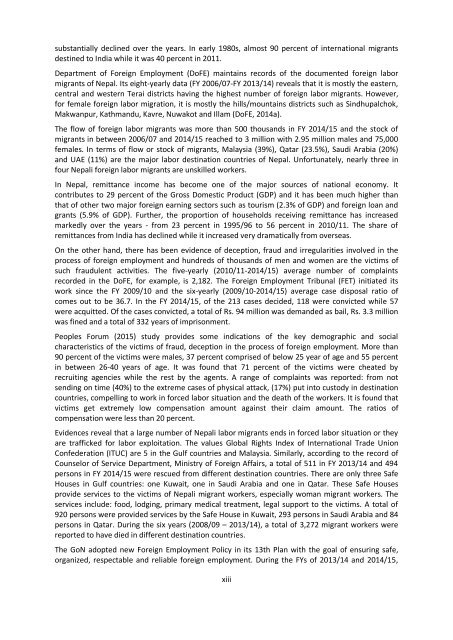TRAFFICKING IN PERSONS
397604438Trafficking_in_Persons_National_Report_2013-15
397604438Trafficking_in_Persons_National_Report_2013-15
Create successful ePaper yourself
Turn your PDF publications into a flip-book with our unique Google optimized e-Paper software.
have been formed in the country. The number of such groups reached to more than 150,000 in FY<br />
2013/14 from about 124,000 in the FY 2011/12. Examining the proportion of women involvement in<br />
the collectivities by social groups, it appears that the women’s programs are highly representative<br />
and inclusive.<br />
One of the key prevention programs of combating sale of children is the education program. The<br />
GoN has been providing different scholarship schemes at different levels of school education. The<br />
schemes aim to expand equitable access of students at corresponding levels, improve retention rate,<br />
and broaden the meaningful teaching opportunities. Despite this, on the average, 500,000 students<br />
enrolled in grades one to 10 tend to drop-out each year in Nepal.<br />
As a prevention and protection program, Child Helpline with toll free number 1098 has been in<br />
operation 12 districts. In FY 2013/14, six organizations operated child helpline and provided different<br />
services to 4,830 children. In the FY 2014/15, there were 577 Child Care Homes in 44 districts of the<br />
country with 16,400 children residing in these Homes.<br />
A number of I/NGOs are involved in anti-trafficking activities in Nepal. Some of the NGOs have<br />
specific anti-trafficking activities, other work in internal trafficking issues while others have activities<br />
related to safe migration, empowerment of women and children. In addition to the prevention<br />
related activities, NGOs provide protection and legal aid services to the trafficked survivors. A total<br />
of 20 NGOs provided information to NHRC about at least one of the protection or legal aid related<br />
services. Accordingly, about 9,000 persons especially women and children were intercepted from<br />
the border areas, bus parks and other places in each of the fiscal year of 2013/14 and 2014/15.<br />
Similarly, 1551 victims in FY 2013/14 and 1971 in FY 2014/15 were rescued mainly from abroad.<br />
More than 3600 victims especially women and children were referred to different organizations for<br />
psychosocial counseling and medical treatment. It is reported that only four NGOs received 1858<br />
missing person applications in FY 2013/14 and 1906 in FY 2014/15. In terms of legal support which<br />
includes FIR, prosecution and court proceeding, a total of 988 persons in FY 2013/14 and 1355<br />
persons in FY 2014/15 were provided legal support by the 11 NGOs.<br />
NGOs mobilized a lot of resources in the year of 2014. A total of 454.7 million Rupees was mobilized<br />
by 27 NGOs affiliated with Social Welfare Council for 63 projects in the year of 2014. Of the total<br />
funding mobilized, 97 percent came from the external donors while about 3 percent was internal<br />
ones. Among the 27 NGOs listed in SWC, the five-top NGOs that mobilized maximum budget in the<br />
year of 2014 include: CW<strong>IN</strong> (38%), Maiti Nepal (14%), WOREC Nepal (10%), Shakti Samuha (5.5%)<br />
and KI Nepal (5%).<br />
Print media coverage in TIP can be evaluated from a recent study conducted by AATW<strong>IN</strong> (2015). It<br />
covered the news and article published in the five national daily newspapers in between April 14,<br />
2014 to April 13, 2015. The newspapers clippings reviewed when the theme of trafficking, migration<br />
or transportation emerged in the newspapers. Of 1007 news articles published, 61.5 percent of news<br />
was related to migration while only 30 percent was related to trafficking. It appears that media has<br />
not prioritized the issue of trafficking as more than three-forth of the news published in the pages<br />
other than first and editorial. Only 38 percent of the news was covered by only one newspaper and<br />
62 percent of the news was event based hard news. Only in 19 percent of the news, the identity of<br />
trafficked survivors is found to have totally protected.<br />
Key challenges in relation to implementation of policies and programs are to strengthen the<br />
Secretariat of National Committee; increase the coordination among the key line agencies; integrate<br />
TIP prevention activities with the poverty alleviation, education and empowerment programs;<br />
reduce the overlap in program interventions and increase the media coverage on trafficking issues<br />
by ensuring the confidentiality and privacy of the victims/survivors.<br />
xv


